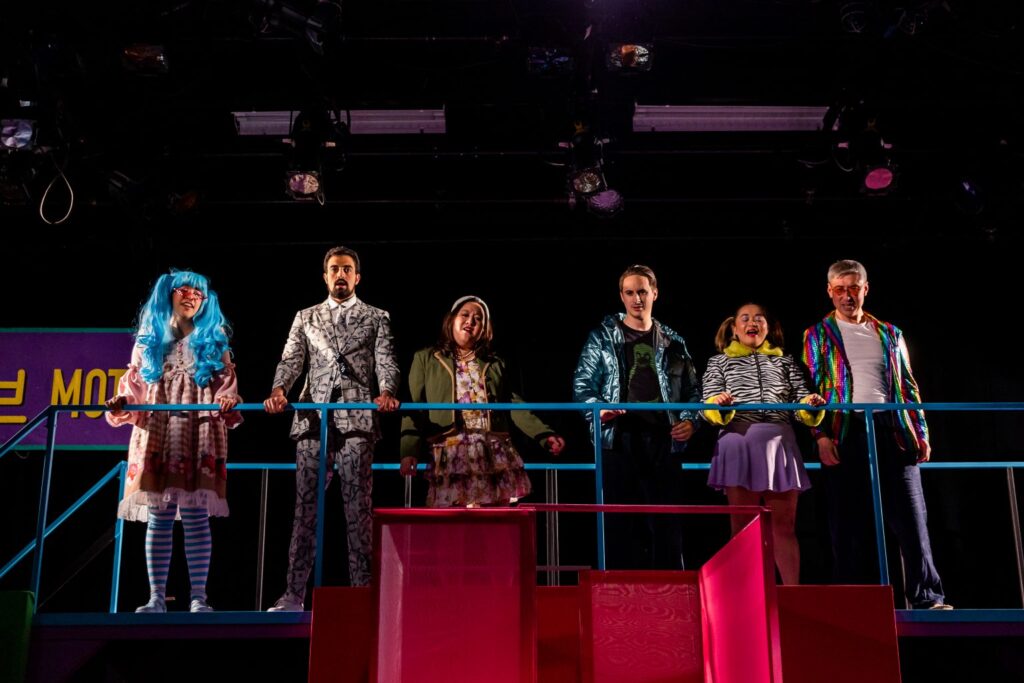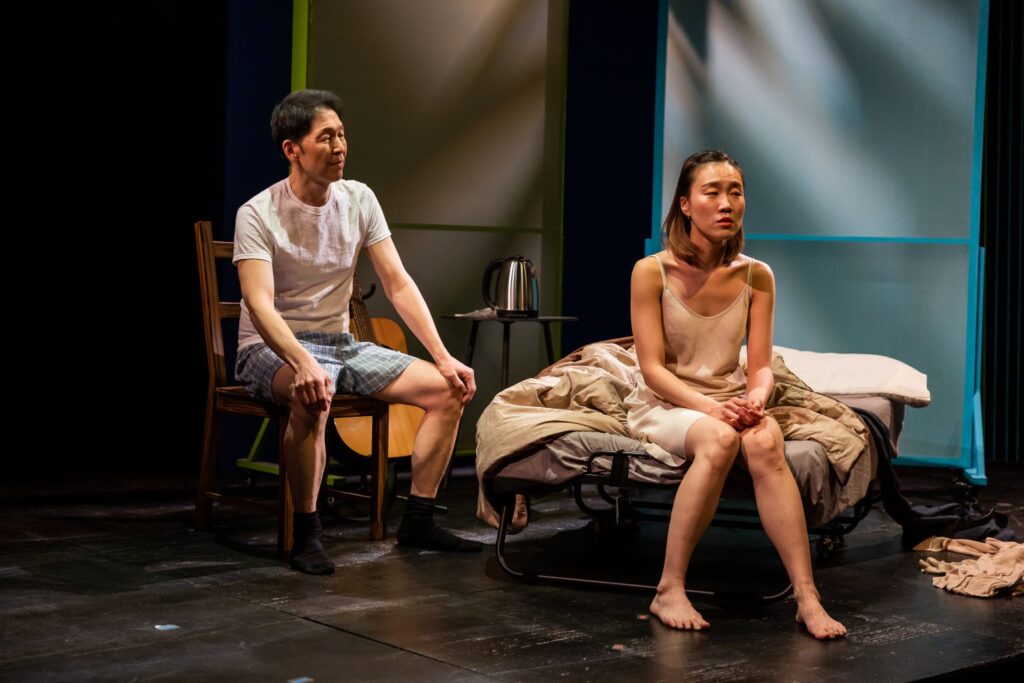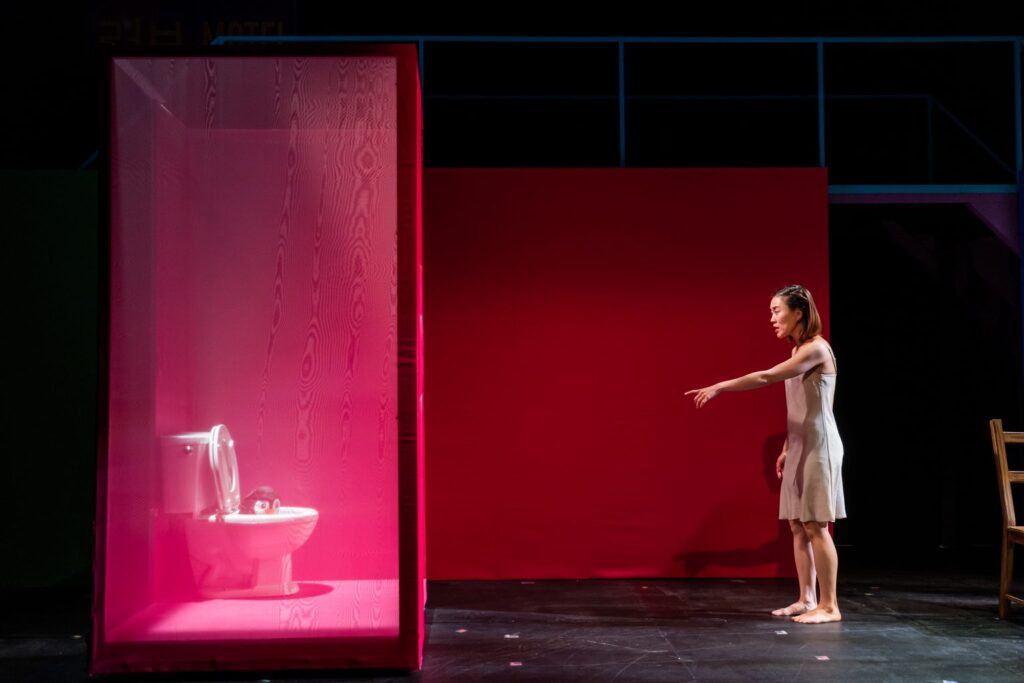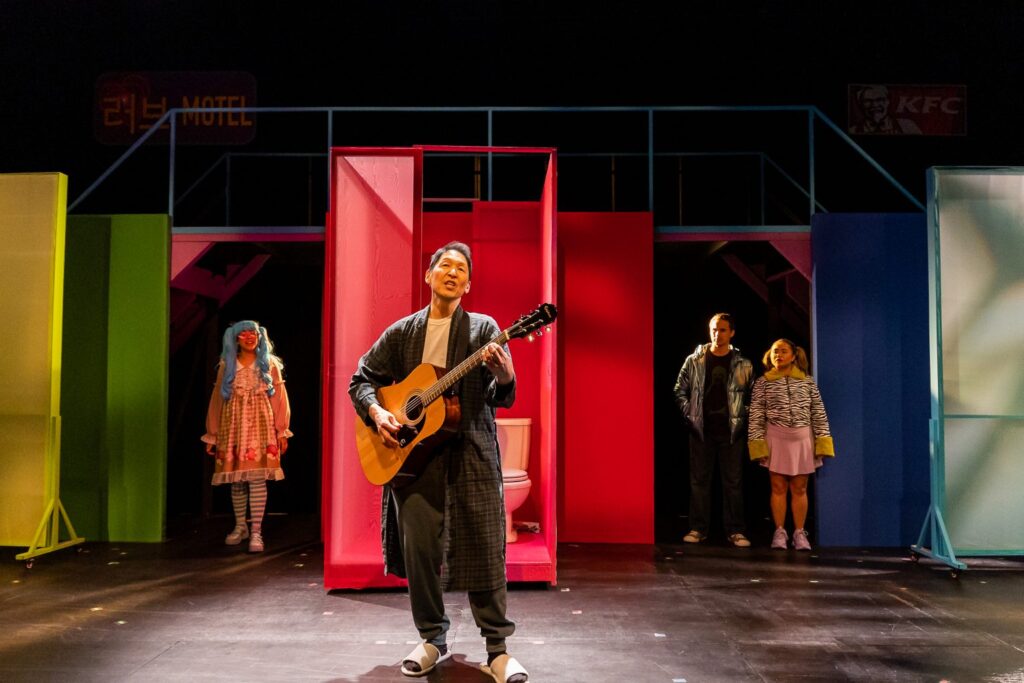
John D. Haggerty in Speakeasy’s ‘Wild Goose Dreams’. Photos by Nile Scott Studios
‘Wild Goose Dreams’ – Written by Hansol Jung. Directed by Seonjae Kim; Scenic Design by Crystal Tiala; Costume Design by Machel Ross; Lighting Design by Kathleen Zhou; Sound Design by George Cooke. Presented by SpeakEasy Stage at The Calderwood Pavillion, Boston through April 8.
By Sophie Kim
Speakeasy Stage’s production of “Wild Goose Dreams,” a play written by Hansol Jung and directed by Seonjae Kim, is a fast-paced, unpredictable, and deliciously fantastical exploration of what it’s like to live your life online, the difficulty of being vulnerable, and the internet as a double-edged sword of loneliness and connection.
Wild Goose Dreams follows Nanhee, who escaped from North Korea to South Korea and is trying to find a way to contact her family, and Minsung, a gireogi appa or “goose father,” who works in South Korea to send money to his wife and daughter in Texas. Nanhee and Minsung meet online and eventually fall in love, but must figure out how to reach out to their families and soothe the feelings of loneliness and isolation that come with twenty-first century life.

The play highlights both the possibility for deep online connection and even deeper loneliness, notably by having actors act as avatars that represent the online versions of Nanhee and Minsung. When Nanhee and Minsung first message each other and plan to meet up for karaoke, their avatars dance around each other, chatting, flirting, and clinking their drinks together as they say the lines that Nanhee and Minsung are typing out loud. However, at the same time, Nanhee and Minsung sit on opposite sides of the stage, staring down at their phones and typing. The contrast between these two interactions, which are really the same interaction, underlines how a virtual conversation can both bring people together, and widen the gulf between them.
It’s also interesting to see who is not embodied in this virtual space. Minsung spends much of the play talking on the phone with his wife and daughter; however, while his daughter is represented by a bubbly, rebellious teenage actor, his wife does not have an avatar, existing only as an imagined voice on the other end of a phone line. This lack of presence further highlights the emptiness of Minsung’s personal life and his hunger for connection.

Creating a fully realized virtual world, with its own tone and language, is no easy task. However, the play utilizes characters, set design and lighting to create a candy-colored funhouse that feels both overstimulating and starkly bare, bound by the constraints of time and free of them. The online world is represented by a loud, bright, hyper-annoying four-person Greek chorus, who yell out notification sounds, headlines, and other online detritus. They talk over each other, on top of each other, and crowd into the characters’ space, mimicking the feeling of the online voices in one’s head, all clamoring for attention.
However, the “annoyingness” of these characters also has a darker side. This is most clearly seen in the second half of the play, when Minsung goes viral after posting a song he has written about feeling suicidal. Minsung strums cheerily on his guitar while singing “I wanna die” over and over, accompanied by the cacophony of the Greek chorus, who shout messages like “I’ll totally sleep with you!”, “So sad. He’s kinda funny though” and “I love K-pop. Please upload more videos!” The whirlwind intensity of the scene and the relentlessness of the comments perfectly encapsulates the cruelty and nihilism of the Internet, while also showing the seductive, all-encompassing feeling of going viral and getting attention, no matter what the reason is.

The set design also helps create this feeling of liminality. The set, composed of glowing pink, green, and blue blocks and hanging pennants mimicking neon signs, feels timeless. Objects also move from the literal to the metaphorical: a toilet onstage first produces a penguin, then becomes a portal from South to North Korea, heightening the feeling of instability in time and space.
The play also utilizes darkness to highlight the intimacy of real-time interactions. When Nanhee and Minsung have sex, one character will ask to turn off the lights. However, instead of one or two lights going out, leaving the rest of the stage lit, all lights onstage will actually go out. This chafes against the audience’s expectations—even when things are “dark” to the characters, they are usually visible to us. However, by leaving the audience in the literal dark, the play suggests that real vulnerability and connection occurs in the spaces that are murky, unknown, and imperceptible to outside parties.
Lastly, the play explores the idea of freedom and what people owe to their families. Throughout the play, Nanhee is plagued by guilt and worry about her family, whom she left in North Korea when she escaped, and is visited by an apparition of her father, who comments on her day-to-day life. In an unexpected twist, one which brings up important questions about what children owe to their parents. For tickets and information, go to: https://speakeasystage.com/

